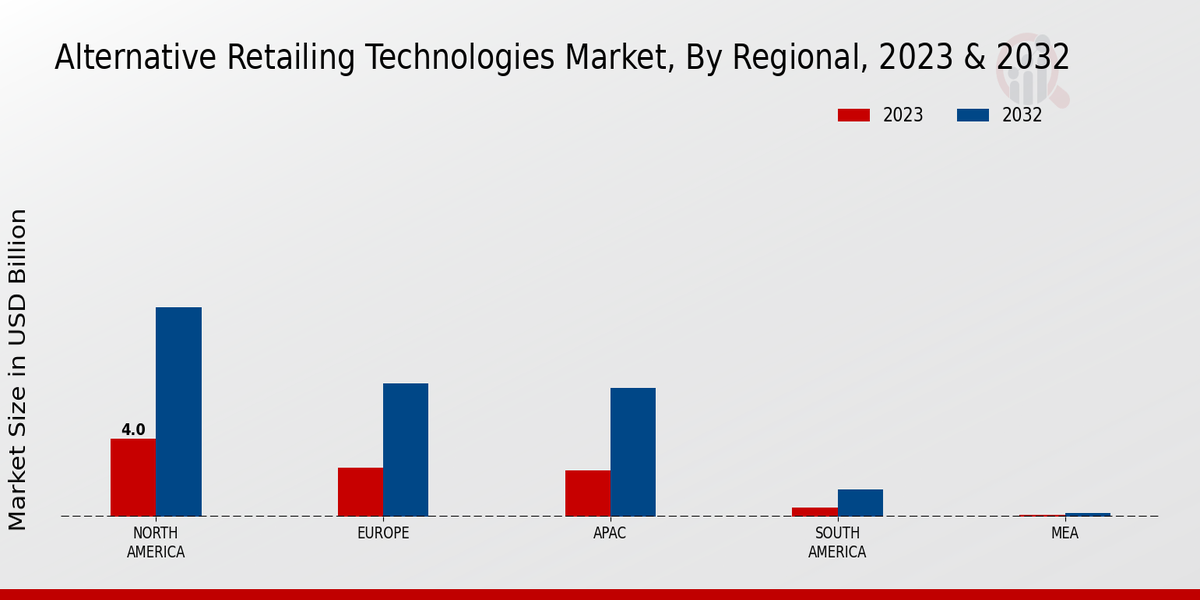E-commerce Growth
The Global Alternative Retailing Technologies Market Industry is significantly influenced by the ongoing growth of e-commerce. As more consumers turn to online shopping, retailers are compelled to adopt alternative technologies to meet evolving consumer demands. The rise of mobile commerce, driven by the increasing penetration of smartphones, is reshaping retail strategies. Retailers are investing in mobile payment solutions and user-friendly applications to enhance the shopping experience. This shift is expected to contribute to a compound annual growth rate of 13.06% from 2025 to 2035, reflecting the industry's adaptation to the digital landscape and the growing preference for online transactions.
Market Growth Projections
The Global Alternative Retailing Technologies Market Industry is projected to experience substantial growth in the coming years. With an estimated market value of 10.4 USD Billion in 2024, it is anticipated to reach 40.1 USD Billion by 2035. This growth trajectory suggests a compound annual growth rate of 13.06% from 2025 to 2035. Such figures indicate a robust demand for alternative retailing technologies as businesses increasingly seek innovative solutions to enhance customer engagement and operational efficiency. The market's expansion reflects the dynamic nature of retail, driven by technological advancements and evolving consumer expectations.
Sustainability Initiatives
Sustainability is becoming a critical driver in the Global Alternative Retailing Technologies Market Industry. Consumers are increasingly prioritizing eco-friendly practices, prompting retailers to adopt sustainable technologies. This includes the implementation of energy-efficient systems, waste reduction strategies, and sustainable sourcing practices. Retailers that embrace these initiatives not only appeal to environmentally conscious consumers but also enhance their brand reputation. The emphasis on sustainability is likely to influence market dynamics, as companies that fail to adapt may struggle to compete. As a result, the market is projected to grow significantly, reflecting the increasing importance of sustainability in retail operations.
Technological Advancements
The Global Alternative Retailing Technologies Market Industry is experiencing rapid technological advancements that enhance consumer experiences and streamline operations. Innovations such as artificial intelligence, augmented reality, and blockchain are being integrated into retail platforms, allowing for personalized shopping experiences and improved inventory management. For instance, AI-driven chatbots are increasingly utilized for customer service, while augmented reality applications enable customers to visualize products in their own environments. These advancements not only improve customer satisfaction but also drive operational efficiency, contributing to the projected market growth from 10.4 USD Billion in 2024 to 40.1 USD Billion by 2035.
Changing Consumer Preferences
The Global Alternative Retailing Technologies Market Industry is shaped by changing consumer preferences, particularly among younger demographics. Millennials and Generation Z consumers are driving demand for innovative shopping experiences that prioritize convenience and personalization. Retailers are responding by integrating technologies such as mobile apps, social media platforms, and interactive kiosks to engage consumers effectively. This shift towards experiential retailing is indicative of a broader trend where consumers seek more than just products; they desire unique experiences. As these preferences continue to evolve, the market is expected to adapt, leading to substantial growth opportunities in the coming years.
Regulatory Support and Incentives
Regulatory support and incentives play a pivotal role in the Global Alternative Retailing Technologies Market Industry. Governments worldwide are increasingly recognizing the potential of alternative retailing technologies to drive economic growth and innovation. As a result, various initiatives and funding programs are being introduced to support the development and adoption of these technologies. For instance, tax incentives for businesses that invest in sustainable technologies or digital infrastructure can stimulate market growth. This supportive regulatory environment is likely to encourage more retailers to explore alternative technologies, contributing to the overall expansion of the market.

























